 Today, the Churches of East and West, liturgically celebrate the Beheading of the Holy and Glorious Prophet, Forerunner, and Baptist John.
Today, the Churches of East and West, liturgically celebrate the Beheading of the Holy and Glorious Prophet, Forerunner, and Baptist John.
The biblical narrative is related in Mark 6: 17-29.
Saint John the Baptist, pray for us!
 Too late loved I thee, O thou Beauty of ancient days, yet ever new! too late I loved thee! And behold, thou wert within, and I abroad, and there I searched for thee; deformed I, plunging amid those fair forms which thou hadst made. Thou wert with me, but I was not with thee. Things held me far from thee, which, unless they were in thee, were not at all. Thou calledst, and shoutedst, and burstest my deafness. Thou flashedst, shonest, and scatteredst my blindness. Thou breathedst odours, and I drew in breath and panted for Thee. I tasted, and hunger and thirst. Thou touchedst me, and I burned for thy peace.
Too late loved I thee, O thou Beauty of ancient days, yet ever new! too late I loved thee! And behold, thou wert within, and I abroad, and there I searched for thee; deformed I, plunging amid those fair forms which thou hadst made. Thou wert with me, but I was not with thee. Things held me far from thee, which, unless they were in thee, were not at all. Thou calledst, and shoutedst, and burstest my deafness. Thou flashedst, shonest, and scatteredst my blindness. Thou breathedst odours, and I drew in breath and panted for Thee. I tasted, and hunger and thirst. Thou touchedst me, and I burned for thy peace.
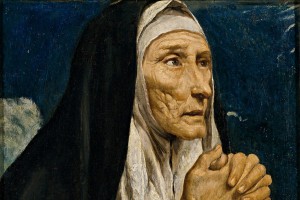 Today the Church remembers Saint Monica (331 – 387), widow and mother of St. Augustine of Hippo. Her vocation is also that of intercessor for others before the Throne of Grace.
Today the Church remembers Saint Monica (331 – 387), widow and mother of St. Augustine of Hippo. Her vocation is also that of intercessor for others before the Throne of Grace.
Monica was born at Thagaste, North Africa of a Christian family. Having married at an early age to Patricius, among her children was the famed Saint Augustine.
Augustine’s brilliant intellect and questionable morals opened the door to being a gyrovague with regard to his spiritual life. Like many of today who attach themselves to trendy yet popular ideologies, Augustine was a Manichee and then a Neoplatonist.
For many years and shedding many tears Monica prayed unceasingly to God for his conversion and her prayers were answered shortly before she died. She had a deep and abiding faith in Christ with the strength of virtue allowing us to follow this wonderful example of a Christian mother.
St. Monica, pray for us.
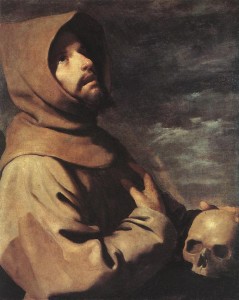 I’m always curious to where the various religious orders are in terms of ministry and the manpower. What can we extrapolate from the numbers and how is the charism lived? Next to the Society of Jesus the Order of Friars Minor are the most significant orders Mother Church has to preach the Gospel and to administer sacraments.
I’m always curious to where the various religious orders are in terms of ministry and the manpower. What can we extrapolate from the numbers and how is the charism lived? Next to the Society of Jesus the Order of Friars Minor are the most significant orders Mother Church has to preach the Gospel and to administer sacraments.
Prescinding what may be several institutional issues like faithfulness to the charism, orthodox teaching, authentic and holy life according to the mind of the founder, and the like, Franciscan friars have taken up the call to serve the Divine Master since the 13th century. The matter becomes: what difference does Jesus and the Church make in the lives of the friars? In the laity who follow the Saint Francis?
Franciscan Friar Father Dominic, a Franciscan historian stationed at St. Bonaventure University in Western New York, presented these facts:
The Order began the year 2015 with a membership of 13,632 friars. This is 113 friars fewer than the previous year, as the growth of the Order in the younger entities cannot yet compensate for the losses in Western Europe and North America. There are 11,794 solemnly professed friars, including 9,243 priests, 59 permanent deacons, 416 friars preparing for ordination, and 1957 lay friars. There was a slight increase of friars in initial formation — 1413 temporary professed and 425 novices. In terms of age, 34% of the world’s friars are under the age of 45, 29% between the ages of 45-64, and 37% over the age of 65.
A closer look at the Order’s six regions shows considerable divergence: four registered growth from the preceding year, whereas two — dominated by elderly friars — posted declines. These were Western Europe, with 3,999 friars, which was down 125 friars from the preceding year, and North America (the U.S. and Canada), with 1,273 friars, which was down 50. On the other hand, the other four regions of the Order showed growth: Latin America, with 3,334 friars, was up 20 friars; Africa, with 1,161 friars (up 30); Asia, with 1423 friars (up 5), and Eastern Europe, with 2442 friars (up 15). To illustrate the age difference among these entities: in the English-speaking Conference, for every friar under the age of 45, there are seven friars over 65. In Africa, on the other hand, the friars under the age of 45 outnumber the seniors 3 to 1.
Holy Name Province has now slipped to the eighth largest of the Order’s 125 entities. Just two years ago, it was fifth largest. The Province of Sts. Francis and James (Jalisco, Mexico) continues to be in first place with 472 friars (120 of whom are in initial formation) The Immaculate Conception Province (São Paolo, Brazil) follows, with 379 members (40 in formation). The third largest entity is now the Immaculate Conception Province (Krakow, Poland), with 338 friars, followed closely by the Province of the Holy Cross (Sarajevo, Bosnia) with 336 members. The German province (Munich) is fifth (322), and the Province of St. Anthony (Venice, Italy), is sixth (309). Slightly ahead of Holy Name (304 friars) is now the Assumption Province (Katowice, Poland) with 307 friars.
In terms of individual nations where the Order is present, Italy still has by far the greatest number of friars (2,038), followed by the United States (1,145), Poland (1,006), Mexico (990), and Brazil (950). It is interesting to note that these five countries comprise almost half the Franciscan friars in the world.
Holy Name, with 304 friars, continues to be the largest entity in the Order’s English-speaking Conference. The other provinces of the ESC are Sacred Heart, based in St. Louis, with 207 members; the Irish Province (which now includes Great Britain), 179; St. Barbara (based in Oakland, Calif.), 168; St. John the Baptist (Cincinnati), 147; Immaculate Conception (New York), 121; Assumption BVM (Franklin, Wis.), 111; St. Joseph (Montreal, Quebec), 68; Our Lady of Guadalupe (Albuquerque, N.M.), 57; Malta, 56; Lithuania, 42; and Christ the King (Edmonton, Alberta), with 33.
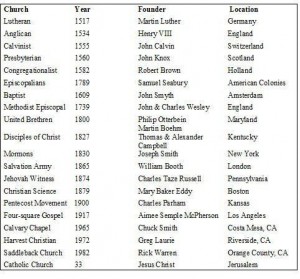 I saw a bumper sticker several years ago that read: “Preaching Jesus Christ since 33 A.D.” One of the Orthodox Churches published it as a way of saying that truth, beauty, goodness and unity are given by Jesus Christ; Christ and the church is not a system of beliefs or policies created at-will. Read carefully the image here.
I saw a bumper sticker several years ago that read: “Preaching Jesus Christ since 33 A.D.” One of the Orthodox Churches published it as a way of saying that truth, beauty, goodness and unity are given by Jesus Christ; Christ and the church is not a system of beliefs or policies created at-will. Read carefully the image here.
There is always the perennial question about following Christ in the Catholic Church: Why does it matter if you leave the Catholic Church? Does it matter if I stay in the Church?
You can have several approaches to the question, but here are the essentials:
1. the truth claims in God as One and Triune; that God is Being itself; that all beauty and unity are defining characteristics of Father, Son and Holy Spirit;
2. Grace –the inner life of the Triune God, not sin, is given to the Catholic Church because its founder, Jesus Christ;
3. Jesus gave his apostles the grace of the sacred Priesthood, and the other sacraments; the Church gave us the Holy Bible, our sacred Scripture revealed by God;
4. Saint Peter was given the pastoral authority and power to preach, teach, and lead the Church to the fullness of the truth, Christ Himself (Matthew 16; 17-19);
5. the power to forgive sins was given by Christ to Peter and Peter to those anointed to share in his ministry down through the ages (apostolic succession, it is called); we follow the Master in the unity and sacramentality of the Church.
Hence, he Catholic Church, was founded by Jesus and she contains the fullness of truth, as promised by Jesus Himself.
The Church is not merely one among many denominations. The Holy Spirit does not divide the truth; there are not personal versions of the truth that claim to set man and woman free. We believe in the objectivity of truth and this truth is not a thing, but a person. There is one Church only: the Catholic Church. In the USA we encounter many groups who claim to be a “church” and to have the fullness of truth. Yet, the question needs to be raised: what do we think of the Protestant groups? The teaching of the Catholic states that each of the groups have some aspect of truth but they do not have the fullness of the truth as revealed by Scripture because they lack valid priesthood and therefore valid sacraments (very few have 7 sacraments that are believed to be instituted by Christ to give grace). As a caveat, we teach and hold that the Orthodox Church has the fullness of truth and sacraments but it lacks true unity with the Body of Christ on earth. One day we will share the Holy Eucharist with the Orthodox.
Catholics are not perfect and they are certainly not holier than other Christians. We are a church of sinners seeking redemption in Christ Jesus. Our belief is that the Catholic Church is both human and divine. And because she shares in Christ’s divinity, it is holy and she will last forever (“I am with you always, to the close of the age.” Matthew 28:19-20). The human side of the church explains the sins, the scandals, unfaithfulness of the people. Logically, though, you cannot claim that the presence of scandals and singer prove that the Catholic Church is false. It proves we need a Savior.
Considering the Christian ecclesial communities and churches, historically we can say that ONLY the Catholic Church existed since the time of Jesus. All other Christian churches have broken from the Catholic Church. Examples: Orthodoxy broke away from unity with the pope in 1054; various mainline Protestant communities were established during the Reformation (1517); and then many of the other smaller groups are breakaways from the Protestant communion.
It is recorded that Church history has lead many unbelievers to search and know the truth. History will demonstrate what the early Church believed about the Eucharist (the Real Presence of Christ in the Eucharist); how and why the early Christians prayed for the dead; what the Lord gave to the Apostles in terms of sacraments; Peter was clearly chosen by the Lord as the leader of His Church; that Mary was loved and honored by the early Christians and understood as the All-holy Mother of God.
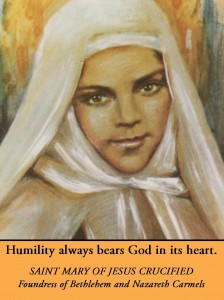 The saints lead us to a deeper relationship with Christ. A new saint of ours, Mary of Jesus Crucified (1846-1878), known in history as Mariam Baouardy (also spelled Mariam Bawardy) was a Carmelite nun. She as a Stigmatic and Victim Soul. She was a communicant of the Melkite Church.
The saints lead us to a deeper relationship with Christ. A new saint of ours, Mary of Jesus Crucified (1846-1878), known in history as Mariam Baouardy (also spelled Mariam Bawardy) was a Carmelite nun. She as a Stigmatic and Victim Soul. She was a communicant of the Melkite Church.
You can read more of her history here.
The biographer of Saint Mary of Jesus says that she heard in a clear voice from Jesus, “This is how everything passes. If you will give me your heart, I shall always remain with you.” These words penetrated and took root in the young heart of Mariam.
Saint Mary of Jesus Crucified, as a Palestinian Carmelite nun was recognized as being filled with the gifts and charisms of the Holy Spirit to an extraordinary degree (think of St Paul). Her mission now is to intercede for us with the Trinity; no doubt one her intentions is ask for the gift of conversion of Islam to Jesus Christ.
Pray to her for peace in the world and Church.
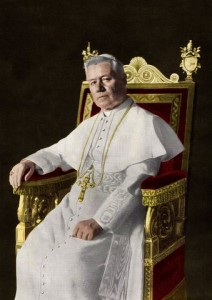 We honor the memory of Saint Pius X, known in history as Giuseppe Melchiorre Sarto. He was the Roman Pontiff from 1903 to 1914. It was 101 years ago that Pope Pius X went to his eternal reward. His last will and testament stated, “I was born poor, I have lived poor, I wish to die poor.” He is known for several instructions on our participation in the holy mysteries: the liturgy of the church.
We honor the memory of Saint Pius X, known in history as Giuseppe Melchiorre Sarto. He was the Roman Pontiff from 1903 to 1914. It was 101 years ago that Pope Pius X went to his eternal reward. His last will and testament stated, “I was born poor, I have lived poor, I wish to die poor.” He is known for several instructions on our participation in the holy mysteries: the liturgy of the church.
The Church prays:
O God, Who didst raise up Saint Pius X to be the chief Shepherd of Thy flock and especially endowed him with devotion to the Blessed Sacrament of the Altar and zeal for Thine eternal truths and a love of the priesthood and the Holy Sacrifice of the Mass, grant we beg of Thee, that we who venerate his memory on earth, may enjoy his powerful intercession in Heaven.
What work did Pope Pius X do for the Church? A lot. He worked the sacred liturgy, the chant tradition and the reform of code canon law; he put energy to improve clergy training and discipline; he established a foundation for scriptural studies and inaugurated the revision of the Latin text of the Bible (we know it as the Vulgate). In the world of politics he emphasized the separation of Church and State and opposed political organizations laying claim to religious sanction. The work that was very dear to heart was his work for peace in the shadows of the outbreak of WWI.
If you want to read some brilliant literature, I’d recommend the Sunday homilies he preached in the courtyards of the Vatican on his favourite theme: the restoration of all things in Christ and the ushering in of peace on earth. One will recall that the restoration of all things in Christ is his motto.
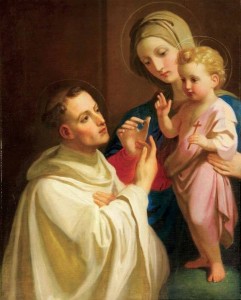 Saint Bernard of Clairvaux composed the famous prayer to the Most Blessed Virgin Mary known as The Memorare. This year is Bernard’s 900th anniversary!
Saint Bernard of Clairvaux composed the famous prayer to the Most Blessed Virgin Mary known as The Memorare. This year is Bernard’s 900th anniversary!
MEMORARE, O piissima Virgo Maria, non esse auditum a saeculo, quemquam ad tua currentem praesidia, tua implorantem auxilia, tua petentem suffragia, esse derelictum. Ego tali animatus confidentia, ad te, Virgo Virginum, Mater, curro, ad te venio, coram te gemens peccator assisto. Noli, Mater Verbi, verba mea despicere; sed audi propitia et exaudi. Amen.
REMEMBER, O most gracious Virgin Mary, that never was it known that anyone who fled to thy protection, implored thy help, or sought thy intercession was left unaided. Inspired with this confidence, I fly to thee, O Virgin of virgins, my Mother; to thee do I come; before thee I stand, sinful and sorrowful. O Mother of the Word Incarnate, despise not my petitions, but in thy mercy hear and answer me. Amen.
Will you join other people across the United States for the 2015 National 54 Day Rosary Novena???
This novena’s primary intention is “For Family and Marriage.”
Would you pray the rosary every day during the 54-day novena (August 15-October 7) for the intention of holy marriages and holy families.
October 7th is the Memorial of Our Lady of the Rosary.
“The National 54 Day Rosary Novena serves as a Message of Hope in response to the spiritual crisis in our culture and nation regarding marriage and family, and in response to the U.S. Conference of Catholic Bishops call to unite in prayer for the intention of the sanctity of marriage and family life. While a novena normally consists of nine consecutive days of prayer, this 54-day rosary novena could be considered an extended novena for this specific intention.”